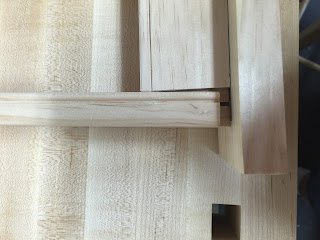I'm currently building the Paul Seller's style clock that he has posted on YouTube. I've enjoyed the build and have maybe one or two afternoons of work left.
One of the things I'm trying really hard to do is not get too far ahead of myself in projects or buying things. I don't like having lots of unfinished or unstarted projects laying around. It stresses me out. That I'm sure has origins from my upbringing. My father is a wonderful man; however, he is the king of unfinished projects and that used to bother me.
The list has grow long enough where I won't need to buy wood for a while. Below is a list of known projects that I have everything I need to get it done.
1. Make another clock. I miscalculated when I bought the board for the first clock and I have enough wood to make a second one. I'm excited about this. I wanted to make at least two if not three of these clocks (first one just gives me the experience and let me knows what the challenges were for me, the second let's me focus more on the challenges, the third is fun as I have a much higher degree of confidence I can build it up to the level of my newbie abilities).
2. Make some more dogs for my bench. I have enough scrap laying about that I can cut a few more square dogs for the bench rather than buying them at $25 each. Only part I don't quite have figured out is how to get a bit of wood springy on the side so the dog stay us. Good problem to solve.
3. I need to make a wood base to go onto my hand powered non-electrical router. I like the one I have but I find the metal base leaves scratches on the wood. I'm sure it's a technique fault on my end but I have a scrap piece of cherry that just fits.
4. Install LED lights under the cabinets under the bench. The garage is well lit but I'd still like more light at the bench. One job I worked at moved us into new offices but I found it dim in my cubicle. So, I purchased some $50 worth of under cabinet LED lighting. When I left the job, I took the lights with me as they were mine. They would go well above the bench and under the cabinets there.
5. Reorganize the cabinets a bit. I initially remodeled the garage with power tools in mind. As such, I put in a lot of cabinets that were tall. Since I decided to go the hand tool route, there isn't much in them and they are poorly organized. If I spend some time on this, I can have some hand tool items that don't go on the peg board really handy. Also, there is a secondary card table in the garage for house hold type tools and items that can reside in the cabinets which will free up space in the garage. I like a neat and tidy garage and doing this goes a long way towards piece of mind for me.
6. Reorganize the hand tools in front of the work bench. Now that I have been working with them for six months, I have a better idea of what I grab often and that which I don't and where along the span of the 8' bench I work. I don't think I need I will be buying too many more tools so it's a good time to do this. Again, peace of mind. When I come home in the evening, even if I can't do any woodworking, just seeing it organize and ready for my use brings great peace of mind. I don't know why this is so. Maybe it has to do with the whirlwind of life and there is much I can't control and this one little place is my fortress of solitude for the rest of the world.
7. Pull nails and sort the wood left from the old fence. It's just laying in a heap in the back yard. Also, the workers were (un)kind enough to leave the pressure treated wood. I want that gone. Being a chemist, having wood that contains chromium and arsenic soaked into revolts me. I don't care what the studies say about it mostly staying put. Nope, it must go and I will be happy when the wood I want to keep is tidy and the pressure treated wood is gone.





















